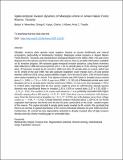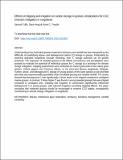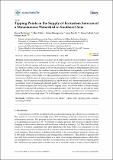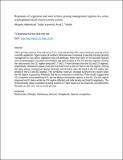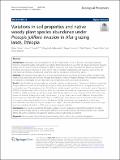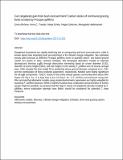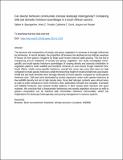Search
Now showing items 11-20 of 28
Spatio-temporal invasion dynamics of Maesopsis eminii in Amani Nature Forest Reserve, Tanzania
(Elsevier B.V., 2020-06-01)
Globally, invasive plant species cause negative impacts to human livelihoods and natural ecosystems, particularly in biodiversity hotspots. Maesopsis eminii invasion in Amani Nature Forest Reserve, Tanzania, was considered ...
Effects of clipping and irrigation on carbon storage in grasses: implications for CO2 emission mitigation in rangelands
(Taylor & Francis Online, 2018-04-03)
Understanding how individual grasses respond to herbivory and rainfall has been hampered by the difficulty of quantifying above- and belowground carbon (C) storage in grasses. Particularly by restoring degraded rangelands ...
Tipping Points in the Supply of Ecosystem Services of a Mountainous Watershed in Southeast Asia
(MDPI, 2018-07-11)
Rubber plantations have expanded at an unprecedented rate in Southeast Asia in recent
decades. This has led to a substantial decline in the supply of ecosystem services (ESS) and has
reduced livelihood options and ...
Responses of vegetation and soils to three grazing management regimes in a semi‐arid highland mixed crop‐livestock system
(John Wiley & Sons, Inc., 2014-10-14)
Three grazing regimes [Cut‐and‐carry (CC), seasonal grazing (SG) and continuous grazing (CG)] currently applied in Tigrai region of northern Ethiopia were compared to identify the best grazing management in key native ...
Variations in soil properties and native woody plant species abundance under Prosopis juliflora invasion in Afar grazing lands, Ethiopia
(Springer Nature, 2020-06-30)
Introduction
Pastoralism and agro-pastoralism are the major modes of life in arid and semi-arid rangelands. However, rangeland quality and quantity are rapidly deteriorating due to a number of natural and human-induced ...
The importance of nutrient hotspots for grazing ungulates in a Miombo ecosystem, Tanzania
(PLOS ONE, 2020-03-30)
While movement patterns of grazing ungulates are strongly dependent on forage quality their use of nutrient hotspots such as termite mounds or grazing lawns has rarely been quantified, especially in savanna ecosystems where ...
Marginalised herders: Social dynamics and natural resource use in the fragile environment of the Richtersveld National Park, South Africa
(Elsevier B.V., 2018)
In the contractual Richtersveld National Park (RNP), park officials and neighbouring communities jointly manage resources, with the aim to harmonize biodiversity conservation and human land use. Our socio-ecological approach ...
Can rangelands gain from bush encroachment? Carbon stocks of communal grazing lands invaded by Prosopis juliflora
(Elsevier Ltd., 2017-06)
Rangeland ecosystems are rapidly declining due to overgrazing and bush encroachment. Little is known about how important bush encroachment is for climate change mitigation. We estimated woody plant biomass at different ...
Can diverse herbivore communities increase landscape heterogeneity? Comparing wild and domestic herbivore assemblages in a South African savanna
(Elsevier, 2015-02)
The structure and composition of woody and grassy vegetation in savannas is strongly influenced by herbivores. In recent decades, the proportion of browsers has declined across African savannas in favour of more grazers, ...
Rangeland forage availability and management in times of drought – A case study of pastoralists in Afar, Ethiopia
(Elsevier, 2017-04)
Many Eastern African rangelands comprise marginal land, where climatic conditions are poor, access rights are increasingly limited, and land degradation is progressing. We conducted participatory land use mapping and ...

